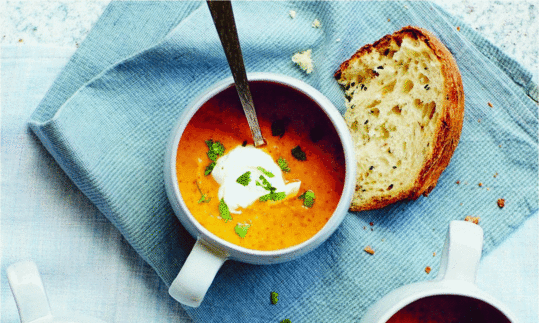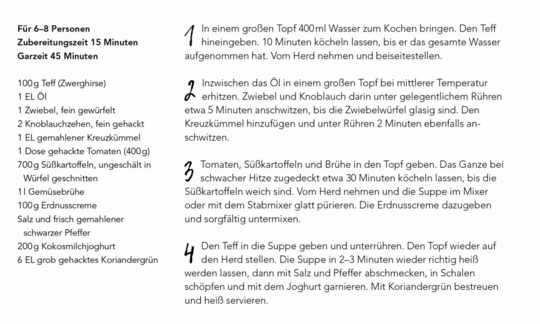Sweet potato and peanut soup with teff and cumin
vegan
Ingredients (for servings, )
| For the soup | |
|---|---|
| 3 ½ oz | Teff (dwarf millet), raw |
| 1 tbsp | Rapeseed oil (canola, HOLL oil, kernel oil), cold pressed?, organic? (0.49 oz) |
| 1 | Onions, raw (organic?) (3.9 oz) |
| 2 cloves | Garlic (organic?) (0.21 oz) |
| 1 tbsp | Cumin, ground (raw, organic?) (0.32 oz) |
| 25 oz | Sweet potatoes, raw |
| 14 oz | Canned tomatoes (chopped, raw?, organic?) |
| 1 liter | Vegetable broth without added salt (organic?) (35 oz) |
| For the nut cream | |
| 3 ½ oz | Peanut butter (peanut puree, raw?, organic?) |
| For seasoning | |
| 1 dash | Table salt (table salt, raw?, organic?) (0.01 oz) |
| 1 dash | Black pepper (organic?, raw?) (0.00 oz) |
| 7 ⅓ oz | Coconut yogurt, vegan (raw?, organic?) |
| 6 tbsp | Coriander leaves, raw (0.15 oz) |
Equipment
- hand-held blender / immersion blender or blender
- stove
- saucepan
Type of preparation
- cook
- sweat
- season to taste
- purée
- remove the skin
Preparation
Cooking the teff
In a large pot, bring four times the amount of water (e.g. 100 g teff = 400 ml water) to the boil. Stir in the teff and simmer for 10 minutes until it has absorbed all the water. Remove from the heat and set aside.You can also prepare the teff the day before. If you soak the grains in fresh water for a few hours before cooking, they will cook more evenly and swell more.
For the soup
Meanwhile, heat the oil in a large saucepan over medium heat. Peel and finely dice the onion and garlic and sauté in the oil for about 5 minutes, stirring occasionally, until the onion cubes are translucent. Add the cumin and sauté for another 2 minutes, stirring.The author did not specify a specific oil. We deliberately chose rapeseed oil, which has a particularly good ratio of omega-6 to omega-3 fatty acids (see tips).
Cut the sweet potatoes into cubes. Add them to the pot together with the chopped tomatoes and the stock. Cover and simmer over low heat for about 30 minutes until the sweet potatoes are soft.
The author does not peel the sweet potatoes. This means that valuable ingredients that are directly under the skin are retained. The amount of fiber is also increased. If possible, use organically grown products if you do not peel them.
We have deliberately chosen vegetable broth with a low salt content to minimize the salt content. You can find more information about this in the tips.
A link to the daughter recipe and information on motivation can be found directly above the recipe picture.
Remove from the heat and puree the soup in a blender or with a hand blender until smooth. Add the peanut cream and mix thoroughly.
Finishing the soup and serving
Add the pre-cooked teff (from step 1) to the soup and stir. Put the pot back on the stove. Heat the soup properly again for 2-3 minutes.Finally, season with salt and pepper, pour into bowls and garnish with the yoghurt. Roughly chop the coriander leaves, sprinkle them over the soup and serve hot.
|
Nutritional Information per person
Convert per 100g
|
2000 kcal | |
|---|---|---|
| Energy | 289 kcal | 14.4% |
| Fat/Lipids | 13 g | 18.2% |
| Saturated Fats | 4.3 g | 21.4% |
| Carbohydrates (inc.dietary fiber) | 39 g | 14.3% |
| Sugars | 8.7 g | 9.7% |
| Fiber | 7.3 g | 29.2% |
| Protein/Albumin | 8.2 g | 16.5% |
| Cooking Salt (Na:207.1 mg) | 526 mg | 21.9% |
| Essential micronutrients with the highest proportions | per person | 2000 kcal | |
|---|---|---|---|
| Min | Manganese, Mn | 2.0 mg | 100.0% |
| Vit | Vitamin A, as RAE | 763 µg | 95.0% |
| Min | Copper, Cu | 0.51 mg | 51.0% |
| Prot | Tryptophan (Trp, W) | 0.09 g | 38.0% |
| Elem | Potassium, K | 733 mg | 37.0% |
| Vit | Vitamin B6 (pyridoxine) | 0.43 mg | 31.0% |
| Prot | Threonine (Thr, T) | 0.26 g | 28.0% |
| Elem | Phosphorus, P | 190 mg | 27.0% |
| Sodium, Na | 207 mg | 26.0% | |
| Min | Iron, Fe | 3.4 mg | 25.0% |
Detailed Nutritional Information per Person for this Recipe
The majority of the nutritional information comes from the USDA (US Department of Agriculture). This means that the information for natural products is often incomplete or only given within broader categories, whereas in most cases products made from these have more complete information displayed.
If we take flaxseed, for example, the important essential amino acid ALA (omega-3) is only included in an overarching category whereas for flaxseed oil ALA is listed specifically. In time, we will be able to change this, but it will require a lot of work. An “i” appears behind ingredients that have been adjusted and an explanation appears when you hover over this symbol.
For Erb Muesli, the original calculations resulted in 48 % of the daily requirement of ALA — but with the correction, we see that the muesli actually covers >100 % of the necessary recommendation for the omega-3 fatty acid ALA. Our goal is to eventually be able to compare the nutritional value of our recipes with those that are used in conventional western lifestyles.
| Essential fatty acids | per person | 2000 kcal |
|---|---|---|
| Linoleic acid; LA; 18:2 omega-6 | 2.3 g | 23.0% |
| Alpha-Linolenic acid; ALA; 18:3 omega-3 | 0.20 g | 10.0% |
| Essential amino acids | per person | 2000 kcal |
|---|---|---|
| Tryptophan (Trp, W) | 0.09 g | 38.0% |
| Threonine (Thr, T) | 0.26 g | 28.0% |
| Phenylalanine (Phe, F) | 0.38 g | 24.0% |
| Leucine (Leu, L) | 0.50 g | 21.0% |
| Valine (Val, V) | 0.33 g | 21.0% |
| Isoleucine (Ile, I) | 0.25 g | 20.0% |
| Lysine (Lys, K) | 0.28 g | 15.0% |
| Methionine (Met, M) | 0.13 g | 14.0% |
| Vitamins | per person | 2000 kcal |
|---|---|---|
| Vitamin A, as RAE | 763 µg | 95.0% |
| Vitamin B6 (pyridoxine) | 0.43 mg | 31.0% |
| Vitamin K | 19 µg | 25.0% |
| Folate, as the active form of folic acid (née vitamin B9 and | 48 µg | 24.0% |
| Niacin (née vitamin B3) | 3.7 mg | 23.0% |
| Biotin (ex vitamin B7, H) | 11 µg | 23.0% |
| Thiamine (vitamin B1) | 0.24 mg | 22.0% |
| Pantothenic acid (vitamin B5) | 1.2 mg | 19.0% |
| Vitamin E, as a-TEs | 2.2 mg | 19.0% |
| Vitamin C (ascorbic acid) | 13 mg | 16.0% |
| Riboflavin (vitamin B2) | 0.15 mg | 11.0% |
| Essential macroelements (macronutrients) | per person | 2000 kcal |
|---|---|---|
| Potassium, K | 733 mg | 37.0% |
| Phosphorus, P | 190 mg | 27.0% |
| Sodium, Na | 207 mg | 26.0% |
| Magnesium, Mg | 92 mg | 25.0% |
| Calcium, Ca | 110 mg | 14.0% |
| Essential trace elements (micronutrients) | per person | 2000 kcal |
|---|---|---|
| Manganese, Mn | 2.0 mg | 100.0% |
| Copper, Cu | 0.51 mg | 51.0% |
| Iron, Fe | 3.4 mg | 25.0% |
| Zinc, Zn | 1.5 mg | 15.0% |
| Selenium, Se | 2.1 µg | 4.0% |
| Iod, I (Jod, J) | 4.1 µg | 3.0% |
| Fluorine, F | 0.92 µg | < 0.1% |
The sweet potato and peanut soup with teff and coconut yoghurt is seasoned with cumin and coriander, among other things.
Portion size: According to the author, this dish is suitable for 6-8 people. We have set the size for a main course at 8 portions.
Nutrient profile: According to GDA guidelines, one portion covers 90% of the average daily requirement of manganese (which plays a role in the formation of cartilage tissue, among other things) and almost 80% of that of vitamin A (important function for the vision process, in the mucous membrane, in the skin and in the immune system). The requirement for the trace element iron, which is involved in oxygen transport in the blood, oxygen storage in the cells and energy metabolism, is covered by 25%. The ratio of omega-6 to omega-3 fatty acids is 12:1, which is significantly higher than the maximum recommended ratio of 5:1 (for more information on this topic, please see the Health section under Tips).
Sweet potatoes: Sweet potatoes, also called sweet potatoes, are not actually potatoes at all. Although they grow as tubers in the ground, unlike ordinary potatoes they are not part of the nightshade family. The leaves of sweet potatoes are also edible and are used as food in tropical countries. The tubers, which have a high water content, cannot be stored as long as conventional potatoes, but their shelf life can be increased by careful handling, such as avoiding bruising. The potato-like tubers come in different colors: yellow with red skin, orange-red with red-brown skin and white with a light skin.
Peanut butter: In general, you should look for a product that is as close to natural as possible. This means no flavor enhancers, no added sugar and as little salt as possible. It is also better to take a look at the nutritional composition rather than just looking at the product name.
Teff: Teff, also known as dwarf millet, originates from Ethiopia and is the smallest grain in the world. Teff is gluten-free and, as there is no peeled teff, it is basically whole grain and therefore rich in vital nutrients. Teff is also one of the grains richest in protein.
Cumin: Due to the similar name, there is often confusion between cumin and caraway. However, they are not closely related and also differ greatly in taste. Cumin is often used in Indian, Turkish and Greek cuisine.
Health: To simply improve the fatty acid composition of this recipe, we have created a health-optimized version of it: Direct link.
You will also find this link and information about our motivation (apple symbol) directly above the recipe picture.
The following article is behind this approach, the content of which we recommend to you: Vegans often eat unhealthily. Avoidable nutritional errors .
Coriander: Opinions vary widely regarding the taste of coriander. Some people react to its intense, slightly soapy aroma with aversion or even nausea. According to statistics, 15% of all allergy sufferers in Switzerland are sensitive to coriander. In these cases, simply leave this ingredient out. However, it is the coriander that gives the dish a special flavor. There is no alternative with a similar taste. Flat-leaf parsley, which looks similar, has a completely different taste.
Peanut butter substitute: For people with a peanut allergy, cashew cream can be used as a substitute for peanut butter. Another alternative is almond cream.





